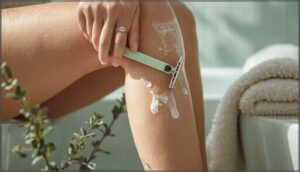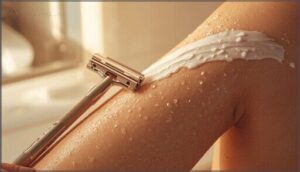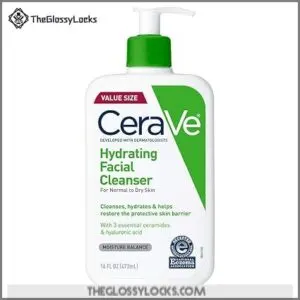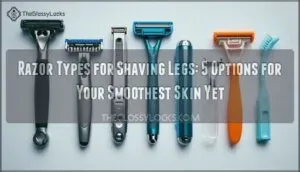This site is supported by our readers. We may earn a commission, at no cost to you, if you purchase through links.
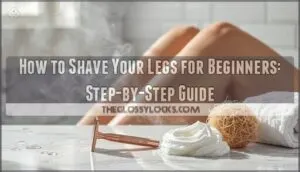
Your first experience with shaving legs for beginners doesn’t need to end with nicks, razor burn, or frustration. Many people approach their initial shave with a dull razor and no preparation, which explains why 60% of beginners report skin irritation after their first attempt.
The difference between a smooth result and an uncomfortable one comes down to technique and preparation. When you understand how to select the right razor, prepare your skin, and follow proper shaving methods, you can avoid the common mistakes that lead to cuts and ingrown hairs.
The process becomes straightforward once you know the steps that protect your skin while delivering smooth results.
Table Of Contents
Key Takeaways
- You’ll avoid the majority of nicks and irritation by using a sharp razor with proper preparation, including a 3-5 minute warm water soak to soften hair and exfoliating 2-3 times weekly to prevent ingrown hairs by up to 39%.
- Manual razors deliver the closest shave but cause redness or razor burn in 78% of users, while electric razors offer gentler results for sensitive skin despite higher upfront costs.
- Your shaving technique matters more than your razor choice—hold the blade at a 30-degree angle, use light pressure with short two-to-four-inch strokes, and always shave with the grain first to minimize irritation on knees and ankles where 42% of beginners get cut.
- Post-shave care isn’t optional—apply fragrance-free moisturizer within three minutes to boost hydration by 36% and reduce irritation by 75%, then use SPF 30+ sunscreen since freshly shaved skin becomes 20% more vulnerable to UV damage.
Choosing The Best Razor for Beginners
Your first shave starts with picking the right razor, and that choice can make all the difference between smooth skin and irritation. Manual razors give you precision and control, while electric options offer speed and safety for beginners worried about nicks.
Let’s break down what works best so you can choose with confidence.
Manual Vs. Electric Razors: Pros and Cons
When you’re starting out, choosing between manual and electric razors comes down to what matters most to you. Manual razors deliver the closest shave but carry a higher risk of nicks and skin irritation—about 78% of blade users report redness or razor burn.
Manual razors give the closest shave but 78% of users experience redness or razor burn
Electric razors cost more upfront yet offer faster shaving with gentler results, making them ideal if you have sensitive skin.
Understanding the shaving technique is key for effective hair removal with either type of razor.
Single-Blade Vs. Multi-Blade Razors
Beyond manual versus electric, you’ll encounter the debate between single-blade and multi-blade razors. Single-blade razors cut hair at the surface, making them better for sensitive skin since they cause less irritation and fewer ingrown hairs. Multi-blade razors deliver premium shave quality with a closer finish in one pass, but they increase skin irritation through repeated friction.
As early as 3000 BC, ancient civilizations used copper-based razors. Your skin’s sensitivity should guide your razor comparison—if you’re prone to razor bumps, a single-blade option offers gentler blade efficiency despite requiring more technique.
Features to Look for in a Razor
After deciding between single and multi-blade razors, you’ll want to examine specific features that improve safety and comfort. Handle ergonomics matter—non-slip grips prevent accidents in wet conditions.
Shaving strips with aloe or vitamin E reduce razor burn by cushioning blade contact. Blade quality determines shave smoothness; sharper edges need less pressure, lowering cut risk.
Safety features like guards limit skin exposure, making choosing the right razor easier for beginners.
How Often to Change Razor Blades
Once you’ve found the right features, maintaining blade sharpness becomes your next priority. You’ll need to change razor blades every 5 to 10 shaves to prevent razor burn and nicks.
Watch for signs like tugging sensations or faded lubricating strips—these indicate dullness. Dull blades increase irritation risk by 62%, so proper razor maintenance through timely blade replacement protects your skin while ensuring consistent shave quality.
Safety Tips for First-Time Users
As a first-time shaving arms and legs beginner, you’ll reduce injury risk by following proper blade hygiene and pressure control guidelines. Approximately 25% of first-timers experience grooming injuries, but you can minimize complications through careful preparation.
- Clean your razor before each use and never share it to prevent infections
- Apply minimal pressure, especially over knees and ankles, to avoid nicks
- Keep antiseptic available for immediate wound care if cuts occur
Choosing shaving products wisely prevents product sensitivity and irritation.
Essential Pre-Shave Preparation Steps
The key to a smooth, irritation-free shave starts before the razor even touches your skin. Proper preparation softens hair, reduces friction, and minimizes your risk of cuts and razor burn.
Let’s walk through the essential steps that will set you up for the best possible shave.
How to Soften Leg Hair and Skin
Softening your leg hair and skin before shaving isn’t just a luxury—it’s essential for preventing irritation. Warm water therapy works by soaking your legs in a warm bath for 3-5 minutes, which hydrates both skin and hair follicles.
A warm shower with steam opens hair cuticles, making them easier to cut. This skin preparation step reduces razor drag and greatly minimizes your risk of razor burn.
Importance of Exfoliating Before Shaving
When you skip exfoliation, dead skin cells block hair exit routes and trap bacteria. Exfoliating before shaving clears these pathways, reducing ingrown hairs by up to 39% and decreasing razor bumps by over 40%.
Exfoliation benefits include:
- Ingrown prevention: Chemical exfoliants lower inflammation by 31%
- Shave closeness: Removes barriers for 33% smoother results
- Product absorption: Moisturizers penetrate 36% more effectively
Dermatologists recommend exfoliating two to three times weekly for best skin preparation.
Choosing and Applying Shaving Cream or Gel
Your choice between shaving cream and shaving gel shapes your entire shaving experience. Shaving cream creates a thick lather that softens hair, while shaving gel offers a transparent layer for precision work. Both contain lubricants like glycerin and dimethicone that reduce friction by up to 60% compared to soap.
| Product Type | Key Ingredients | Best For |
|---|---|---|
| Regular Cream | Glycerin, coconut oil | Normal skin types |
| Sensitive Cream | Aloe, chamomile | Irritation-prone areas |
| Clear Gel | Dimethicone, sorbitol | Precision shaving |
| Moisturizing Gel | Hyaluronic acid, vitamin E | Dry skin conditions |
Apply your chosen shaving product after warming your legs for 3 to 5 minutes. Use light, circular motions to distribute an even layer across the entire area you’ll shave. This creates a protective barrier that helps your razor glide smoothly while maintaining moisture in each hair follicle. Proper application reduces post-shave irritation by 44% and increases comfort for 88% of users.
Preparing Sensitive Skin for Shaving
Preparing skin for shaving demands attention when you have sensitive skin. Start by cleansing with a pH-balanced wash to reduce barrier disruption by up to 29%. Your pre-shave protection routine should layer products that work together:
- Use gentle exfoliation 2-3 times weekly to decrease ingrown hairs
- Apply pre-shave oil to reduce friction and razor burn by 44%
- Maintain routine consistency across all products for 68% fewer irritations
Product synergy protects against skin sensitivity and minimizes post-shave irritation.
When is The Best Time to Shave Legs?
Timing shapes your shaving experience more than you’d expect. Evening shaving gives your skin overnight recovery and reduces irritation visibility by morning. Shower timing effects matter too—shaving after exposure to steam opens hair follicles for closer results.
Morning vs. evening depends on skin sensitivity impact: tighter morning skin increases discomfort, while nighttime warmth conceals missed hairs. These leg shaving tips improve your skin preparation routine considerably.
Step-by-Step Shaving Techniques
Now that your legs are prepped and ready, it’s time to pick up the razor. The way you hold it, move it, and care for it during the process makes all the difference between smooth skin and irritation.
Let’s walk through the essential techniques that’ll help you shave confidently and safely.
How to Hold and Angle The Razor
With proper razor grip, you set the foundation for a safe, effective shaving technique. Hold the handle lightly—no death grip needed—and position the blade at roughly 30 degrees to your skin. This angle lets razor blades glide smoothly without dragging or cutting.
Keep pressure control gentle; modern multi-blade razors don’t require force. Use short stroke lengths of two to four inches, rinsing between passes to prevent common mistakes like clogging.
Shaving Direction: With or Against The Grain
Once you’ve got your angle down, shaving direction becomes your next decision. Most leg hair grows downward, so shaving with the grain—moving down from knee to ankle—lessens irritation factors and aids ingrown prevention.
You’ll notice shaving against the grain delivers smoother results, but beginners should start with the grain. This shaving technique protects sensitive skin while you build confidence, even if smoothness perception takes a slight hit initially.
Navigating Knees, Ankles, and Curves
Knees and ankles demand extra attention—over 42% of first-time shavers report cuts around these bony areas. Bend your knee slightly to create a taut surface, reducing injury risk by 28%.
Around ankles, prop your foot securely and use short strokes under two inches. Light pressure with proper blade angles prevents deeper cuts by up to 50%, especially on curves where bone sits close to skin.
Preventing Nicks, Cuts, and Missed Spots
Sharp blades matter—dull ones boost nicks by 42%. You’ll prevent cuts by maintaining light pressure control and proper shaving angle, reducing injury by 37%.
Skin hydration before shaving techniques lowers irritation by 31%. Lighting matters when preventing razor burn and razor bumps on your legs.
Run your hand over smooth legs after drying to catch missed spots—43% of beginners find patches this way.
Rinsing and Cleaning The Razor During Shaving
After every two strokes, rinse your razor under warm running water—68% of women report clogging when they skip this step. Proper rinsing frequency protects against bacterial buildup and extends blade life.
Expert recommendations emphasize hygiene—razors harbor up to 4.9 million bacteria without cleaning methods during shaving.
- Hold blades under warm water for 3-5 seconds
- Tap handle gently to dislodge trapped hair
- Inspect grooves for remaining shaving cream
- Shake excess water before continuing
Effective Post-Shave Care and Maintenance
Your work doesn’t end when you rinse off the last bit of shaving cream. What you do in the minutes and days after shaving can mean the difference between smooth, comfortable legs and red, irritated skin.
Let’s cover the essential steps you need to take care of your skin and keep your razor in top condition.
Moisturizing Immediately After Shaving
Your skin loses natural oils when you shave, so moisturizing immediately afterward isn’t optional—it’s essential postshave care. Applying a fragrance-free, alcohol-free moisturizer within three minutes boosts skin hydration by 36% and reduces irritation by 75%.
This simple step helps with barrier repair, locks in moisture, and promotes long-term health. Choose products with ceramides or glycerin for best results in your aftercare for shaved skin routine.
Treating Razor Burn, Bumps, and Ingrown Hairs
Despite your best efforts, razor burn, razor bumps, or ingrown hairs sometimes appear after shaving. Cool compresses reduce immediate skin irritation by constricting blood vessels.
Apply hydrocortisone cream to calm inflammation, or use aloe vera for natural soothing. If bumps become infected, topical antibiotics prevent complications.
When irritation persists, stop shaving for several days—your skin needs time to heal before your next session.
Soothing and Protecting Sensitive Skin
Sensitive skin demands extra attention after shaving to prevent razor burn and irritation. Choose fragrance-free, alcohol-free moisturizers that hydrate without triggering inflammation.
- Apply cooling treatments like aloe vera to calm erythema immediately
- Use hydration boosters with hyaluronic acid to repair your skin barrier
- Avoid irritants such as harsh soaps that strip natural oils
Sun protection with SPF 30 shields vulnerable post-shave skin from UV damage and hyperpigmentation.
Cleaning and Storing Your Razor Safely
Your razor blades harbor millions of bacteria after each shave, so rinse your razor thoroughly under hot water to flush away debris. Cleaning frequency matters—scrub with mild soap after every use to prevent bacterial buildup and infection risks.
Following proper cleaning protocols, air-dry completely before storing in a dry place away from humid bathrooms. This simple routine protects blade longevity and your skin’s health in a safe storage environment.
Sun Protection After Shaving
Freshly shaved skin loses its protective barrier, making it up to 20% more vulnerable to UV sensitivity and sunburn. You need immediate protection to prevent inflammation and long-term damage.
- Apply broad-spectrum sunscreen (SPF 30+) after moisturizing to shield against both UVA and UVB rays
- Choose fragrance-free, non-comedogenic formulas to avoid irritating freshly shaved skin
- Reapply every two hours during sun exposure, especially when swimming or sweating
- Wear protective clothing like wide-brimmed hats during peak hours (10 a.m. to 4 p.m.)
- Wait 5-10 minutes post-shave before sunscreen application to minimize stinging
Combining moisturizing with proper sun protection aids your skin’s healing while reducing premature aging risks.
Top Products for Smooth Beginner Leg Shaving
Choosing the right products can make your first shaving experience easier and more comfortable. The items below work well for beginners because they’re gentle on skin while still giving you smooth results.
Here are three dermatologist-recommended products that’ll help you get started with confidence.
1. Venus Comfortglide Olay Sugarberry Razor
The Venus Comfortglide Olay Sugarberry Razor combines five blades with built-in Olay moisture bars, making it an excellent choice for beginners learning to shave legs properly. Its ergonomic metal handle provides control during your first attempts, while the SkinCushion technology reduces irritation by 50% compared to standard lubricating strips.
You won’t need separate shaving cream because the moisture bars release body butters and vitamin E when wet. The sugarberry fragrance adds a pleasant touch, and the pivoting head helps navigate knees and ankles with confidence.
2. CeraVe Hydrating Facial Cleanser For Dry Skin
CeraVe Hydrating Facial Cleanser works effectively on your legs, not just your face. This non-foaming formula contains hyaluronic acid and three ceramides that support skin hydration while you cleanse before shaving. The lotion-like texture won’t strip moisture from dry skin, and its MVE Delivery Technology releases moisturizing ingredients throughout the day.
You’ll find it particularly helpful if you have sensitive skin or eczema-prone areas. The fragrance-free, non-comedogenic formula maintains your skin’s natural barrier without causing irritation.
Clinical studies demonstrate its effectiveness in improving skin care for very dry skin conditions.
3. Cetaphil Gentle Skin Cleanser Hydrating Wash
Cetaphil Gentle Skin Cleanser offers another excellent pre-shave option for sensitive skin care. Its micellar technology lifts dirt without disrupting your skin’s natural barrier, while glycerin, panthenol, and niacinamide deliver hydration benefits that last up to 48 hours.
The soap-free, fragrance-free formula won’t trigger skin irritation before shaving. You can apply it with or without water—just wipe off excess to leave a protective layer that softens hair and readies skin.
Clinical data from over 32,000 patients confirms its effectiveness as a moisturizer for pre-shave use on sensitive areas.
Frequently Asked Questions (FAQs)
Can I shave with dry skin?
You shouldn’t shave dry skin. Dry shaving increases razor burn, cuts, and ingrown hairs while stripping natural oils.
Always hydrate skin first with warm water and use shaving cream to protect your skin barrier.
How long does smooth skin last?
You’ll enjoy smooth skin for about one to three days after shaving legs. Hair regrowth rate varies by person, but most notice stubble within 48 hours—unlike waxing, which lasts weeks longer.
Does shaving make hair grow back thicker?
No, shaving doesn’t make hair grow back thicker. Scientific evidence confirms it only cuts hair at the surface, leaving hair follicles unaffected.
Blunt hair tips create the illusion of thicker leg hair, debunking common hair growth myths.
What if I get a cut?
Cuts happen—don’t panic. Stop the bleeding with gentle pressure using a clean cloth.
Prevent infection by rinsing with lukewarm water. Apply antiseptic cream to reduce scarring and soothe irritation, then moisturize once redness fades.
Should I shave before or after working out?
You should shave after working out. Post-workout shaving reduces skin irritation and infection risk because your hair is hydrated and pores are open, making hair removal gentler with less friction than shaving beforehand.
Conclusion
Practice makes perfect, and shaving legs for beginners becomes easier with each attempt. Your first shave sets the foundation for a routine that protects your skin and delivers consistent results.
When you prioritize sharp blades, proper preparation, and gentle technique, you lessen irritation and heighten smoothness. The steps outlined here address the specific challenges beginners face, giving you the knowledge to approach each shave with confidence and achieve the comfortable, nick-free results you’re looking for.
- https://www.webmd.com/teens/shaving-tips-girls
- https://www.gillettevenus.com/en-us/womens-shaving-guide/how-to-shave/how-to-shave-legs/
- https://www.reddit.com/r/SkincareAddiction/comments/pytnyb/skin_concern_my_legs_are_awful_from_shaving_yes_i/
- https://en.wikipedia.org/wiki/Leg_shaving
- https://www.aad.org/public/everyday-care/skin-care-basics/hair/how-to-shave




